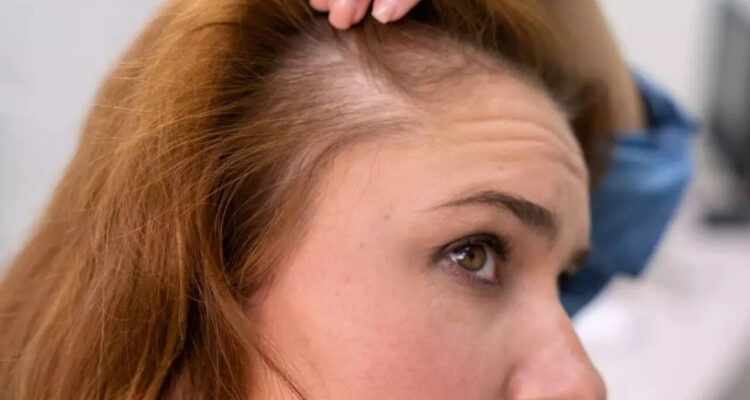
Noticing hair thinning in your 20s may not have been something you anticipated, yet it’s more common than you might think. These could be early warning signs that you shouldn’t ignore, whether you’ve noticed a wider part, more hair in your brush, or subtle changes at your hairline. At Vinci Hair Clinic, a lot of our customers initially think they are too young to be concerned about hair loss. The reality? Early hair thinning is on the rise, often due to a combination of genetics, stress, lifestyle habits, or underlying health concerns.
This article will help you recognise the early indicators of hair thinning, understand the potential causes, and explain why acting quickly is crucial for preserving your hair—and your peace of mind.
Understanding the Early Warning Signs of Hair Loss in Your Twenties At this stage in life, hair loss is not always as severe as the appearance of bald spots. Early thinning, on the other hand, typically shows up in subtle ways, so you might not notice it unless you pay close attention. Common signs of hair thinning in your 20s include:
A widening part: More scalp is visible when you part your hair.
a receding hairline, particularly in the area of the temples. Visibility of the scalp: Photographs and bright lighting make your scalp stand out more.
Excessive shedding: You might notice more hair on your brush, in the shower, or on your pillow. A ponytail that is thinner: A lower volume could be an early sign of thinning. Wispy regrowth: Fine hairs near the hairline that fail to grow fully.
If you’ve noticed any of these symptoms, it’s a good idea to investigate without delay.
Why is hair loss common in 20-somethings? Hair thinning during your 20s can be caused by various factors, with many cases resulting from a mix of issues.
Some of the most frequent causes we encounter at Vinci Hair Clinic include the following:
1. Genetics (Androgenetic Alopecia)
Younger generations frequently experience an earlier onset of hair loss than older generations. Men may experience crown thinning or a receding hairline as a result. It frequently appears as diffuse thinning across the top of the scalp in women.
2. Hormonal Imbalances
Hair growth cycles can be disrupted by PCOS, thyroid disorders, and hormonal treatments like birth control.
3. Pressures on one’s life and stress
Your 20s can be an especially stressful decade filled with new responsibilities like university, job changes, or personal transitions. Emotional stress, combined with physical factors like illness, poor sleep, or rapid weight changes, could lead to a temporary shedding condition known as telogen effluvium.
4. Nutritional Deficits Intake of nutrients is essential for healthy hair
Young people often have thin, fragile hair because they don’t get enough protein, iron, zinc, or vitamin D. 5. Styling and Damage
Excessive heat styling, bleaching, and harsh chemicals all have the potential to harm hair and exacerbate thinning. Is Hair Thinning in Your 20s Reversible?
Thinning hair does not always indicate permanent hair loss. Early action, combined with the right treatment and care, can often stabilise or reverse the damage before it progresses.
At Vinci Hair Clinic, we focus on creating tailored treatment strategies that address the root cause of your hair thinning. From nutritional advice to advanced treatments, we provide holistic solutions to achieve the best outcomes for your unique situation.
Treatments for Hair Loss in Your 20s That Work PRP (Platelet-Rich Plasma) Therapy This natural therapy uses growth factors extracted from your blood to stimulate weakened hair follicles and promote regrowth.
Minoxidil (Maxogaine) on the skin This treatment, which has been proven clinically and is applied directly to the scalp, increases blood flow and encourages hair to remain in its growth phase for a longer period of time. Finasteride, which is for men a prescription drug that effectively slows or stops men’s hair loss by blocking DHT, a hormone that causes genetic hair loss.
Scalp Micropigmentation
By pigmenting thinning areas, this non-surgical method gives the appearance of thicker, fuller hair. When to Seek Expert Advice If you’ve noticed consistent changes to your hair’s appearance over the last three to six months, don’t wait to seek professional guidance. Hair thinning rarely resolves on its own, but early diagnosis opens up a wider range of options for treatment and preservation.
At Vinci Hair Clinic, we provide no-cost consultations to examine your medical history, assess the health of your scalp, and recommend the best course of action. Our clinics are conveniently located throughout the UK and worldwide, ensuring accessible expert care.
Take Action Today
When you start losing hair in your 20s, it’s not just about looking better; it’s also about feeling good about yourself and taking control of your appearance. You don’t have to face it alone, whether you’ve noticed more obvious or more subtle shifts. By addressing hair thinning early, you create the best opportunity to maintain and restore volume. Don’t hesitate to take that first step towards regaining confidence with expert support by your side.

